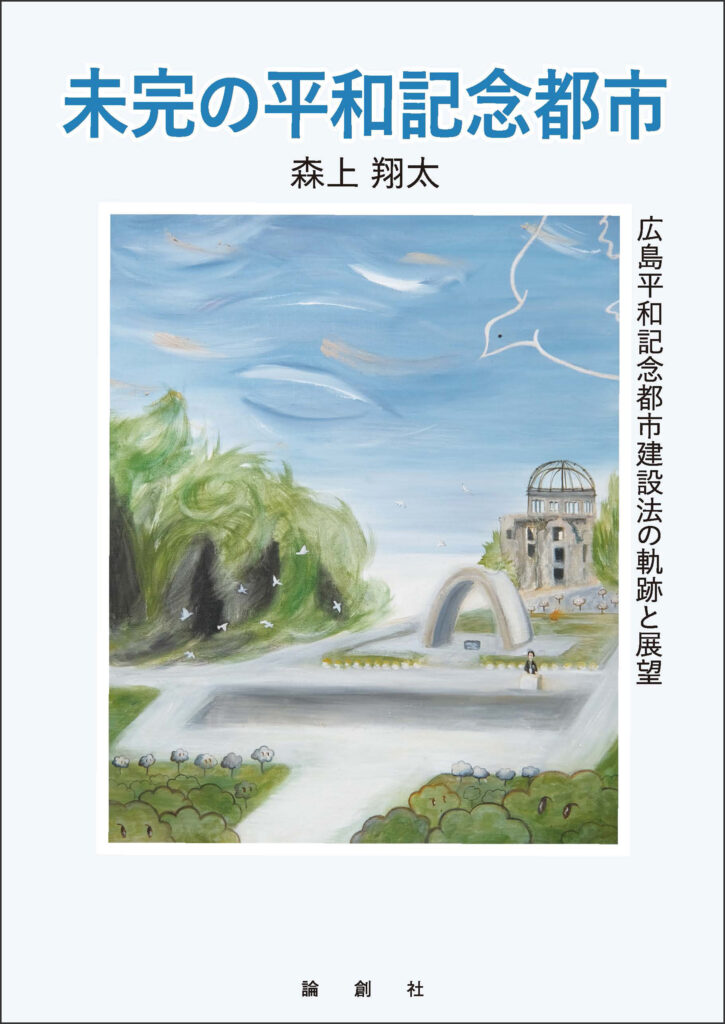森上 翔太(講師)
1 「平和」概念の変遷
⑴ 原爆平和招来説
先月(2025年7月)、米国のトランプ大統領が、広島・長崎への原爆投下が第二次世界大戦を終結させたという趣旨の発言をし、被爆地から強い批判の声が上がったことは記憶に新しい。本稿では、トランプ発言の真偽や是非ではなく、そのような言説、いわゆる「原爆平和招来説」[1]が、終戦直後の広島において一定程度受け入れられていたという事実に目を向けたい。
例えば、1947年の第1回平和祭において、浜井信三・広島市長は、平和宣言の中で、広島に投下された原爆が「戦争の継続を断念させ、不幸な戦を終結に導く原因となったことは不幸中の幸いであった。この意味に於て8月6日は世界平和を招来せしめる機縁を作った」と述べている[2]。
もちろん、その背景には、連合国軍総司令部(GHQ)によるプレス・コードの影響があった。原爆に関する報道や言論がGHQによって厳しく監視される中、原爆平和到来説は、それでもなお原爆に言及することのできる安全なフレーズとして、次第に定式化していったものと考えられる[3]。
⑵ 広島平和記念都市建設法
楠瀬常猪・広島県知事は、早くも1945年12月19日の中国新聞において、「広島は原子時代という世紀を画する原子爆弾で潰滅し…これが終戦への一つの導因となった」との認識(原爆平和招来説)を示した上で、「私はこの広島が戦争終結をもたらした平和への記念都市となるため全世界の有志から復興資金、資材を募りたいと思う」と述べている[4]。
この「戦争終結をもたらした平和への記念都市」という概念は、その後、広島平和記念都市建設法(1949年8月6日公布・施行)に取り込まれ、広島市は、「恒久の平和を誠実に実現しようとする理想の象徴」たる「平和記念都市」として「建設」されることとなった(第1条)。この条文は、制定されたばかりの日本国憲法(1946年11月3日公布・1947年5月3日施行)の前文及び第9条を強く意識して立案されたものである。
⑶ 「平和」概念の多義性
それ以来、広島市は平和都市としての歩みを続けてきた。しかし、広島市が掲げる「平和」の意味は必ずしも一定ではなく、時代や社会の変化と共に変化してきた[5]。そもそも広島平和記念都市建設法においてすら、第二次世界大戦の終結を意味する「平和」と、日本国憲法が掲げる「恒久の平和」という、異なる二つの「平和」概念が共存している[6]。前者は戦争の記憶が生々しく残る当時の現実を、後者は新憲法制定を受けた理想主義的な風潮を、それぞれ色濃く反映したものである。
1954年のビキニ事件を契機に原水禁運動が全国的な広がりを見せると、「平和」概念に核兵器廃絶という要素が盛り込まれることとなる[7]。さらに、2001年に制定された広島市男女共同参画推進条例は、「平和とは紛争や戦争のない状態だけをいうのではない。すべての人が差別や抑圧から解放されて初めて平和といえる。」(前文)として、いわゆる積極的平和の概念を盛り込んでいる。
2 「平和」概念の可能性
こうした変遷に鑑みると、「平和」とは、特定の意味や価値を持った概念ではなく、その時々の状況や立場に応じて描かれる「理想の社会の在り方」といった程度の薄い意味しか持たないのではないかと思われる。言い換えれば、「平和」とは器のようなものであり、誰が、何を込めるかによって中身が変わるものである。
このことは、必ずしも「平和」概念の価値が下がることを意味しない。むしろ、老子の言葉に「埏埴以為器、当其無、有器之用」——粘土で器を作るとき、その器に無(空洞)があるからこそ器として使えるのだ——とあるとおり、「平和」もまた、特定の意味や価値にコミットしないからこそ、かえって多様な意味や価値を受け入れるための柔軟性が生まれ、その結果、異なる考えや価値観の衝突が絶えない現実において、多様な立場の人々にとっての共通の言語や対話の場となり得るのである。
もちろん、「平和」という言葉の下に集う者たちが同じ理想を描いているとは限らない。それどころか、同床異夢であることの方が多いかもしれない。しかし、その「同床」すら失われつつある現在の国際社会において、せめて「平和」という言葉だけでも共通の土俵として機能するのであれば、その意義は決して小さくない。
このように、世界で最初の被爆都市となった広島がその後80年にわたって歩んできた「平和都市」としての道のりを振り返ると、器としての「平和」が持つ可能性——対話と協調に向けた最後の砦——が見えてくる。

[1] 原爆平和招来説については、直野章子『原爆体験と戦後日本——記憶の形成と継承』(岩波書店、2015年)71–75頁参照。
[2] 「昭和22年(1947年)平和宣言」広島市ホームページ[https://www.city.hiroshima.lg.jp/atomicbomb-peace/1036662/1003065/1036188/1026925/1008133.html](2025年7月15日閲覧)
[3] 森上翔太『未完の平和記念都市——広島平和記念都市建設法の軌跡と展望』(論創社、2024年)153頁。
[4] 「楠瀬知事の広島復興の構想 平和への記念都市 資金は世界の有志から」『中国新聞』1945年12月19日。
[5] より一般的な「平和」概念の多様性については、佐渡友哲「平和学の発展過程と今日的課題——グローバリゼーションの時代の視点から」『政経研究』第53巻第2号、2016年10月、150–152頁参照。
[6] 前掲、森上125頁。
[7] 最近の例では、2021年に制定された広島市平和推進基本条例において、「平和」が「世界中の核兵器が廃絶され、かつ、戦争その他の武力紛争がない状態」(第2条)と定義されている。
Peace as a Vessel: Reflecting on the Evolution and Possibilities of the Concept of Peace Eighty Years After the Atomic Bombing
Shota Moriue (Lecturer)
1. The Transition of the Concept of Peace
(1) The Theory that the Atomic Bomb Brought Peace
In July 2025, U.S. President Donald Trump stated that the atomic bombings of Hiroshima and Nagasaki ended World War II—a remark that drew intense criticism from both cities. This short essay does not seek to verify the accuracy or legitimacy of such a statement. Rather, it turns attention to the historical fact that this type of discourse—the so-called “theory that the atomic bomb brought peace[1]”—was, to a certain extent, accepted in Hiroshima in the immediate aftermath of the war.
For example, during the first Hiroshima Peace Festival held in 1947, then-Mayor Shinzo Hamai stated in his Peace Declaration that “the dropping of the atomic bomb became a factor in ending the war and calling a halt to the fighting. In this sense, mankind must remember that August 6 was a day that brought a chance for world peace[2].”
Behind this rhetoric lay the influence of the press code enforced by the General Headquarters of the Allied Forces (GHQ), under which all reports and statements about the atomic bomb were subject to strict censorship. Under such constraints, the theory that the bomb brought peace became a relatively safe phrase for referencing the bomb, and gradually came to be formalized in public discourse[3].
(2) Hiroshima Peace Memorial City Construction Law
As early as December 19, 1945, then-Governor of Hiroshima Prefecture, Tsunei Kusunose, wrote in the Chugoku Shimbun, “Hiroshima was destroyed by an atomic bomb that marked the beginning of the atomic age... this became one of the causes that brought the war to an end.” Having expressed this recognition, he added, “I would like Hiroshima to become a peace memorial city that brought about the end of the war, and for this, I hope to collect funds and materials for reconstruction from supporters around the world.”
This idea of a “peace memorial city" that brought about the end of war was later incorporated into the Hiroshima Peace Memorial City Construction Law, promulgated and enacted on August 6, 1949. According to Article 1, Hiroshima was to be constructed as a “peace memorial city” that serves as a symbol of "the human ideal of sincere pursuit of genuine and lasting peace.” This article was carefully drafted with strong reference to the newly enacted Constitution of Japan—specifically its Preamble and Article 9.
(3) The Polysemous Nature of “Peace”
Since that time, Hiroshima has continued to walk its path as a city of peace. However, the meaning of “peace” as advocated by Hiroshima has never been monolithic. It has evolved in response to the times and prevailing social conditions. Even in the Peace Memorial City Construction Law, we can already observe the coexistence of two distinct notions of peace: the “peace” symbolizing the end of World War II and the “perpetual peace” enshrined in the Constitution of Japan[4]. The former reflects the reality of the immediate postwar period when memories of war remained vivid, while the latter embodies the idealism fostered by the new constitutional order.
Following the 1954 Bikini Atoll nuclear test by the U.S., the anti-nuclear movement gained national traction, and the concept of “peace” expanded to encompass the abolition of nuclear weapons. Furthermore, the Hiroshima City Gender Equality Promotion Ordinance, enacted in 2001, embraced the notion of positive peace in its preamble, stating: “Peace does not simply mean the absence of conflict or war. True peace exists only when all people are liberated from discrimination and oppression.”
2. The Possibilities of the Concept of Peace
In light of these transitions, it appears that the concept of “peace” does not possess a fixed meaning or inherent value, but rather carries only a contingent meaning—one that reflects an ideal form of society as imagined according to the historical and sociopolitical context of the time. In other words, peace may be best understood as a vessel: its contents change depending on who fills it, and with what.
This does not imply a devaluation of the concept of peace. On the contrary, as Laozi once wrote: “Mold clay into a vessel; it is the emptiness within that makes it useful” (埏埴以為器、当其無、有器之用). Likewise, it is precisely because peace is not committed to any singular meaning or value that it gains the flexibility to accommodate a wide variety of interpretations and values. This flexibility, in turn, allows peace to function as a shared language or platform for dialogue among people with different perspectives in a world where conflicts of ideas and values are ever-present.
Of course, those who gather under the banner of ‘peace’ do not necessarily envision the same ideal. More often than not, they may be engaged in what the saying “different dreams in the same bed” suggests—a state of shared appearance but differing intentions. Nonetheless, in today’s international society—where even the “shared bed” is becoming elusive—if the term “peace” can still function as a common ground, however minimal, then its significance is far from negligible.
As we reflect on the eighty-year journey of Hiroshima—the first city to suffer an atomic bombing—as a city of peace, we begin to discern the profound potential of peace as a vessel: to serve as the final bastion for dialogue and cooperation.
[1] Akiko Naono, Genbaku Taiken to Sengo Nihon: Kioku no Keisei to Keishō [The Atomic Bomb Experience and Postwar Japan: The Formation and Transmission of Memory] (Tokyo: Iwanami Shoten, 2015), 71–75.
[2] https://www.city.hiroshima.lg.jp/english/peace/1029846/1029847/1029855/1009948.html (accessed on July 15, 2025)
[3] Shota Moriue, Mikan no Heiwa Kinen Toshi [The Incomplete Peace Memorial City] (Tokyo: Ronso-sha, 2024), 153.
[4] Ibid., 125.

